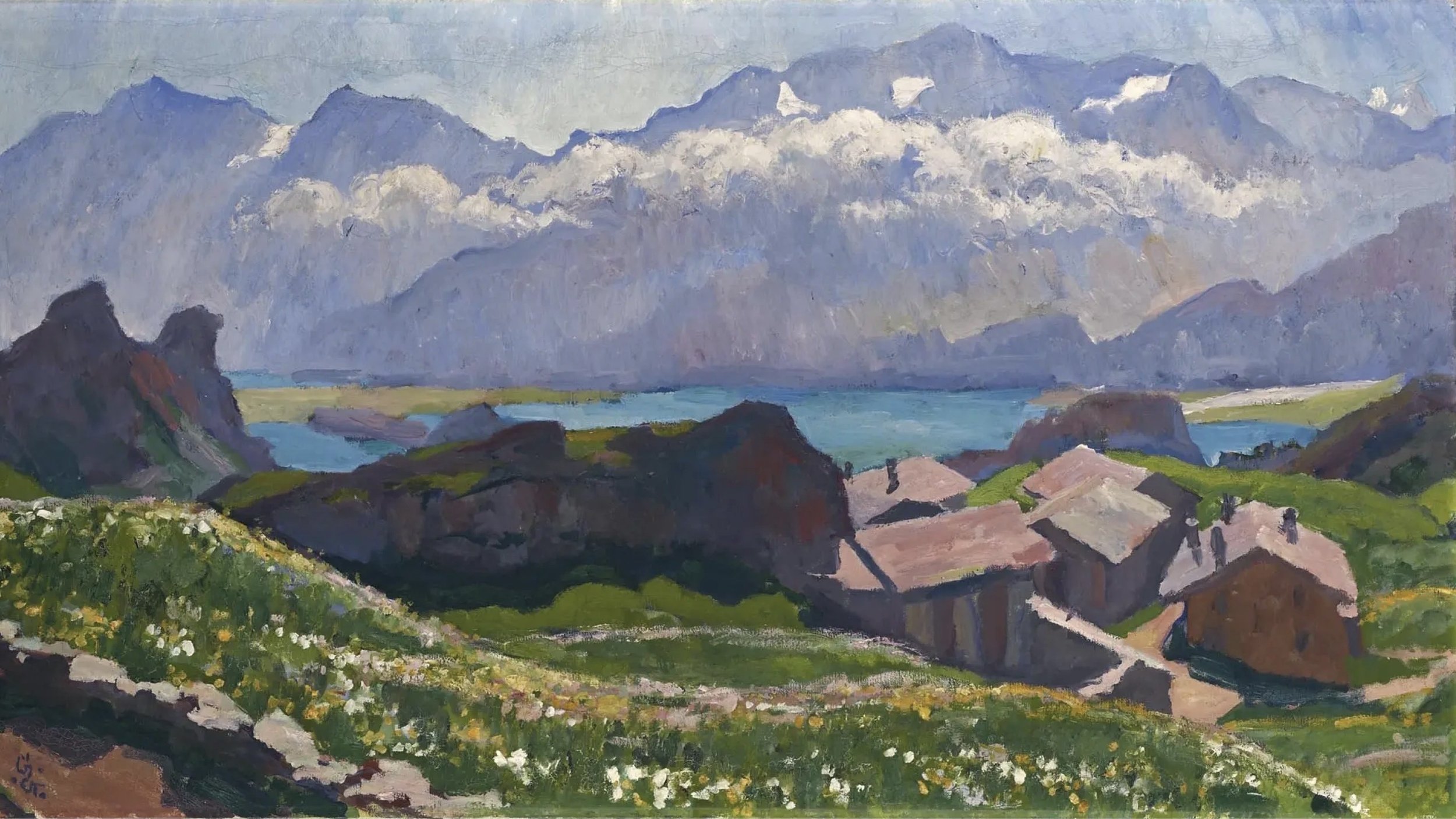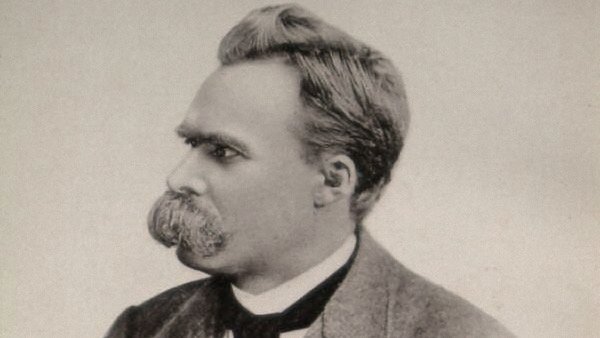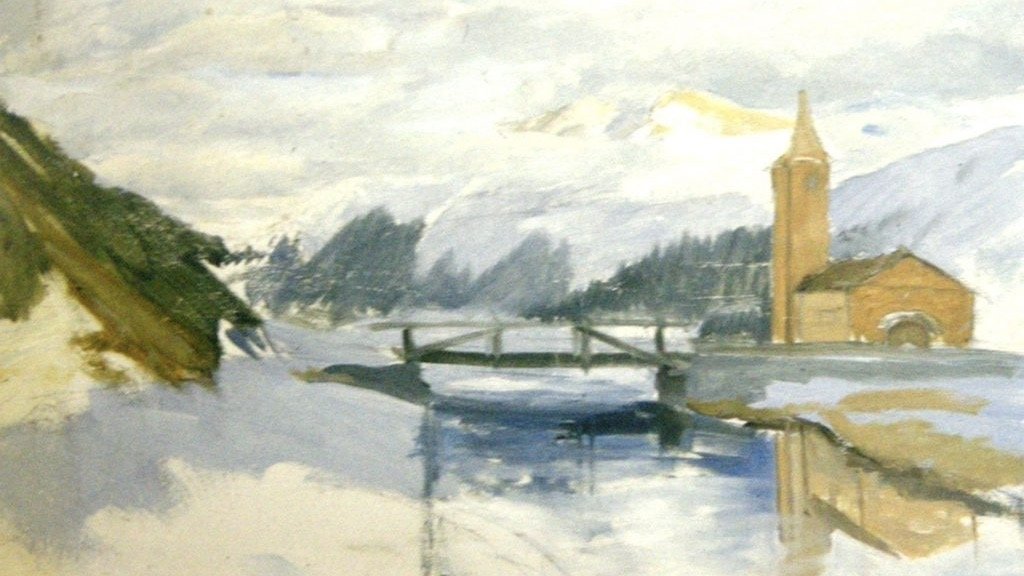
Peter Robert Berry II
Zeitgenossen
Kein Künstler steht für sich allein. Auch Peter Robert Berry war von seinen Zeitgenossen beeindruckt und nahm viele Einflüsse auf. Der vielleicht wichtigste war die Kunst und die Person von Giovanni Segantini (1858 – 1899). Seine divisionistische Maltechnik wie auch seine Bildsprache sollten für Berrys künstlerisches Schaffen inspirieren. Weil der staatenlose Segantini unweit von St. Moritz in Maloja eine Heimat gefunden hatte, lernte Berry ihn persönlich kennen.
Giovanni Giacometti (1868 – 1933) war im Bergell zuhause, das westlich an das Engadin anschliesst. Mit ihm verband Peter Robert Berry eine innig empfundene Freundschaft. Im Herbst 1898 fühlte sich Peter Robert Berry so stark zur Malerei hingezogen, dass er seinen Freund in einem berührenden Brief bat, ihn den Umgang mit Ölfarben zu lehren. Leider kam Berry mit seinem Anliegen ungelegen, Giacometti vertröstete den Ratsuchenden auf den Winter. In seinem Antwortschreiben aber nahm er warmen Anteil und unterstützte den Freund in seinem Wunsch zu malen.
Zu anderen persönlichen Bezugspersonen zählen der Schweizer Maler Ferdinand Hodler (1853 – 1918), der Philosoph Friedrich Nietzsche (1844 – 1900) sowie der Silser Maler Andrea Robbi (1864 – 1945).

Giovanni Segantini
(1858 – 1899)
Als sich Giovanni Segantini 1894 mit seiner Familie in Maloja niederliess, war er ein bekannter Maler. Seine Bilder wurden in den Museen in Berlin und Wien, Hamburg und München, Rom und Mailand, Liverpool und San Francisco gezeigt. Die Engadiner Hoteliers wollten sich diese Ausstrahlung des Künstlers zunutze machen, und der umtriebige Hotelier des Maloja Palace, A. Walther-Denz, konnte Segantini für die Idee eines Engadiner Panoramaprojekts für die Weltausstellung des Jahres 1900 in Paris gewinnen.
Das Panorama sollte als grossartige Werbung für das Engadin dienen. Am 7. Oktober 1897 stellte Segantini das Projekt einem kleinen Kreis Interessierter vor, am 14. Oktober sprach der Maler vor über 100 Personen im Hotel Bernina in Samedan und hielt in flammenden Worten die touristische Werbewirksamkeit eines solchen Projekts fest: «Unser Engadin muss in der Welt mehr geschätzt und bekannt werden, und zu diesem Zwecke wird sich vielleicht niemals eine günstigere Gelegenheit darbieten, als jene, die uns die grosse Ausstellung gibt, die Paris am Ende des Jahrhunderts als Rendezvous der Intelligenz und des Reichtums bietet.»
Zu den begeisterten Befürwortern der ersten Stunde gehörte auch Peter Robert Berry II. Segantini erschien ihm bei seiner Hinwendung und Auseinandersetzung mit der Schönheit der Bergwelt als leuchtendes Vorbild. So verfasste er aus medizinischer Sicht eine engagierte «Studie über die Bedeutung eines Engadin-Panoramas in Paris bei Anlass der Weltausstellung». Darin ist die Bewunderung für Segantinis Kunst aus jeder Zeile herauszuhören.
Mit der Tochter Bianca Segantini verband ihn in späteren Jahren eine innige Freundschaft, auch gehörte Peter Robert Berry II zu den Mitbegründern des Segantini Museums: Das «Comitato per il Museo Segantini» erteilte dem St. Moritzer Architekten Nikolaus Hartmann jun. 1907 den Auftrag, eine Gedenkstätte für den Künstler zu entwerfen. Auch Peter Robert Berry III, der Sohn des Malers, war 40 Jahre lang Präsident dieses «Comitato».

Giovanni Giacometti
(1868 – 1933)
Nach dem Besuch der Kunstgewerbeschule in München studierte Giacometti von Oktober 1888 bis Mai 1891 an der Académie Julian in Paris. Nach Graubünden zurückgekehrt wurde er zu einem zentralen Protagonisten der künstlerischen Auseinandersetzung mit der Landschaft des Bergells und des Engadins. Er gilt als der Maler, der den Post-Impressionismus in die Schweiz brachte, und ist der Vater des Avantgardisten Alberto Giacometti (1901 – 1966).
Berry schrieb am 6. September 1898 an Giacometti: «Letzten Herbst trieb ich mich, gereizt von jenen wunderbaren Farbensymphonien der Herbstlandschaft, einem unwiderstehlichen Drange folgend, wochenlang mit Farbenstiften & Skizzenbuch, auf den Bergen herum, um zu skizzieren. Allein, ich musste gar bald die betrübende Erfahrung machen, daß die kalten, harten Farbenstifte meine malerische Empfindung nicht wiederzugeben vermochten. Ich griff daher zum Pastellstift, ohne die geringste Ahnung, wie man damit umgeht. Eine so entstandene Skizze entspricht einigermaßen meiner künstlerischen Intention, ohne mich jedoch zu befriedigen. Ich möchte daher im Herbst, wo ich beruflich ‹entlastet bin›, von Herzen gerne lernen, wie man Oelfarbe verwendet & möchte Dich hiemit anfragen, ob Du wohl Zeit & Lust hättest, mir diesen sehnlichsten Wunsch zu erfüllen? (...) Du kannst es mir, als Künstler, unschwer nachfühlen, wie mächtig der Drang in mir sein muß, um Dich, trotz allen Gründen, welche mich bisher davon abgehalten, um einen solchen Freundschaftsdienst anzugehen, weiß ich doch, wie sehr der Maler, & Künstler überhaupt, der Ruhe & Stille bedarf, um seinem Werke zu leben! Indessen hoffe ich doch, daß Du mich verstehen werdest, daß Du mir vielleicht einige Stunden opfern könntest, für welche ich Dir von Herzen verbunden wäre (...).»

Ferdinand Hodler
(1853 – 1918)
Hodler wird als Symbolist und Künstler des Jugendstils eingeordnet, gilt aber gleichzeitig durch seine intensive Auseinandersetzung mit der Natur als einer der wichtigsten Maler der Alpenlandschaft. Er war um 1900 ein berühmter internationaler Vertreter der Schweizer Kunst und gewann auf der Weltausstellung in Paris drei Goldmedaillen.
Aus einem Brief, den Ferdinand Hodler am 24. März 1907 aus St. Moritz an Giovanni Giacometti nach Stampa schrieb, ist zu schliessen, dass sich Hodler und Peter Robert Berry II im Winter 1907 in St. Moritz kennenlernten. Vom Besuch, dem Austausch und einer näheren Beziehung zwischen Hodler und der Familie Berry zeugen zwei Skizzen, die Hodler seiner Gastgeberin Maria Berry-Rocco gewidmet und in ihr Gästebuch gezeichnet hat.
Später wird Berry in seinen Erinnerungen festhalten, dass ihm Hodler geraten habe, ganz zur Malerei überzugehen. Über seine Begegnung mit Berry schreibt Hodler an Giacometti: «Ich habe nun hier [in St. Moritz] schon vieles gesehen und viele gute Bekanntschaften gemacht, unter anderen auch der Dr. Bärri [gemeint ist Peter Robert Berry II], der sehr gut malt und gewiss schon ein sehr tüchtiger Maler ist. Er hat hübsche Farben, man fühlt überhaupt, dass er in einem guten Milieu zwischen dir und Segantini aufgewachsen ist.»

Friedrich Nietzsche
(1844 – 1900)
Friedrich Nietzsche gehört zu den vermutlich bekanntesten Philosophen der Welt. Ursprünglich klassischer Philolologe, bekam er bereits 1867 einen Ruf als Professor an die Universität Basel. Aus gesundheitlichen Gründen zog er sich jedoch aus der Lehre zurück und weilte anschliessend häufig im Engadin.
Als Friedrich Nietzsche 1879 erstmals in das Hochtal in Graubünden kam, um sich von seinen drückenden Leiden zu erholen, fand er sich selbst in dieser Landschaft gleichsam gespiegelt. Beglückt schreibt er an seinen Freund, den Theologen Overbeck, nach Basel: «Aber nun habe ich vom Engadin Besitz ergriffen und bin wie in meinem Element, ganz wundersam! Ich bin mit dieser Natur verwandt.»
Verschiedene Zeugnisse weisen darauf hin, dass Nietzsche während dieses ersten Engadin-Aufenthalts bei der Familie Berry in St. Moritz Quartier genommen hat. So erinnert sich Peter Robert Berry II an eine Begegnung mit dem ruheliebenden, stillen Herrn, der in der Dachkammer der Viletta logierte, gleich unterhalb des Elternhauses mit freier Sicht auf den See, dort studierte und schrieb. Von 1881 an verbrachte Nietzsche dann mehrere Sommer im beschaulicheren Sils-Maria.
Berry begann schon früh, Nietzsche zu lesen. Nachdem er 1895 seine Stelle als St. Moritzer Kurarzt aufgegeben hatte, war er noch im selben Jahr während seines Studienaufenthalts in Berlin erstmals auf Nietzsches Schriften aufmerksam geworden. In seinem Nachlass befinden sich die Gesammelten Werke. Viele Bücher sind durch Unterstreichungen und Randnotizen gezeichnet und geben Einblick in die Intensität seiner Lektüre. Oft sollte Berry später in seinen Aufzeichnungen festhalten, dass Nietzsche sein Leben verändert habe.

Andrea Robbi
(1864 – 1945)
Andrea Robbi wuchs in Carrara in der Toscana sowie in der piemontesischer Kleinstadt Saluzzo bei Turin auf, wo seine Eltern die Pasticceria Methier & Robbi führten. Den Sommer verbrachte die Familie jeweils in Sils Maria, dem Herkunftsort von Andreas Vater Rudolf Robbi. Robbi und Peter Robert Berry II verbrachten ihre Schulzeit als Gymnasiasten zusammen an der Kantonsschule Chur.
Wie Berry kehrte auch Robbi nach Jahren des Kunststudiums in die Heimat zurück und liess sich in seinem Heimatdorf Sils Maria nieder. Nach 1900 schloss sich Robbi immer stärker von seiner Umwelt ab und war schliesslich im Dorf als «Dachs», als Einzelgänger, bekannt. Was man bisher über Andrea Robbis Leben weiss, deutet darauf hin, dass er die Malerei nach 1900 fast gänzlich aufgab, zu einem Zeitpunkt also, als Berrys Laufbahn erst ihren Anfang nahm.
Der herausragende Künstler Andrea Robbi wurde erst in den 1980er Jahren entdeckt. Heute sind seine Bilder, die durch ihre sensible Farbigkeit und gelungenen Kompositionen bestechen, im Sils Museum der Andrea Robbi Stiftung in Sils Maria ausgestellt.






